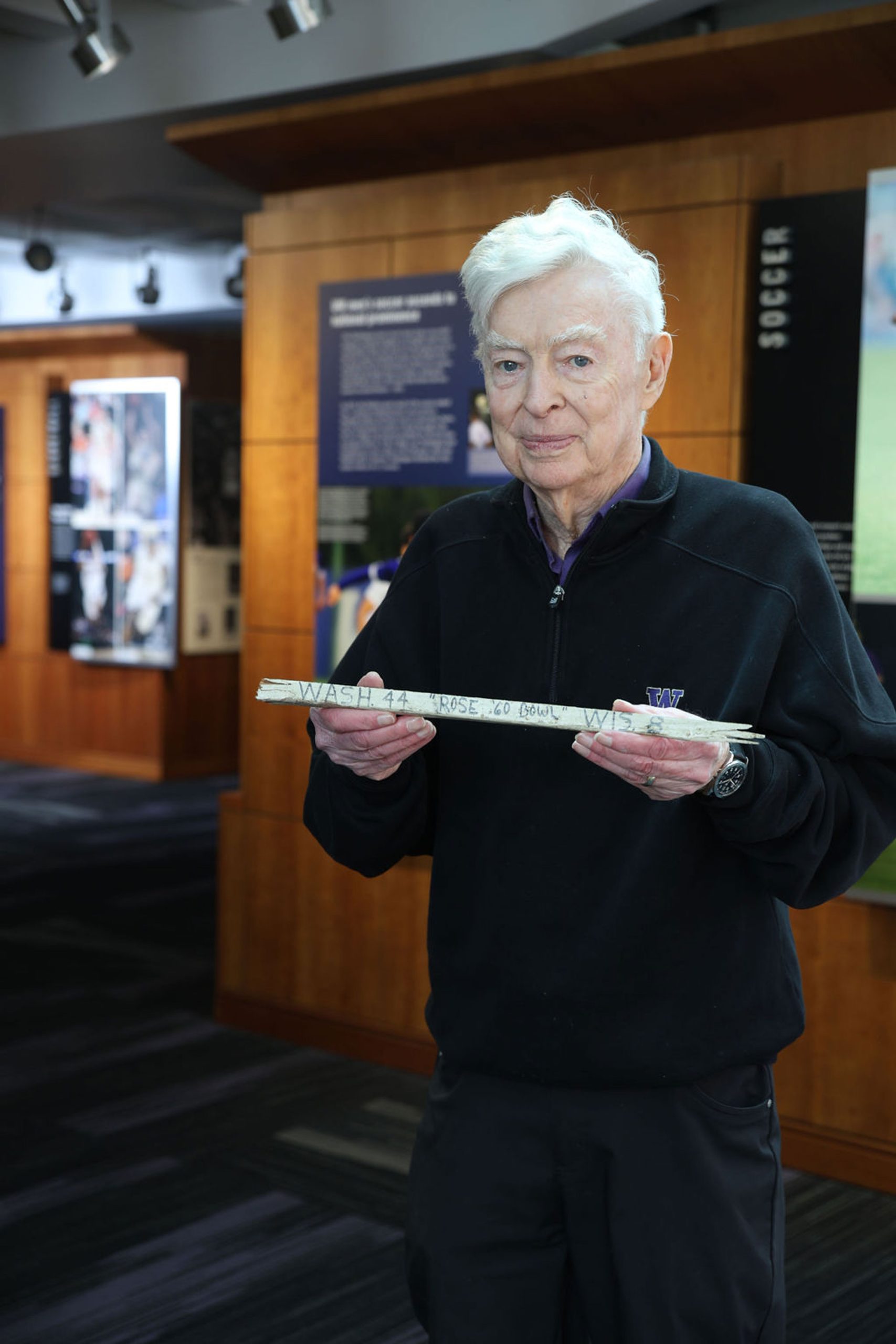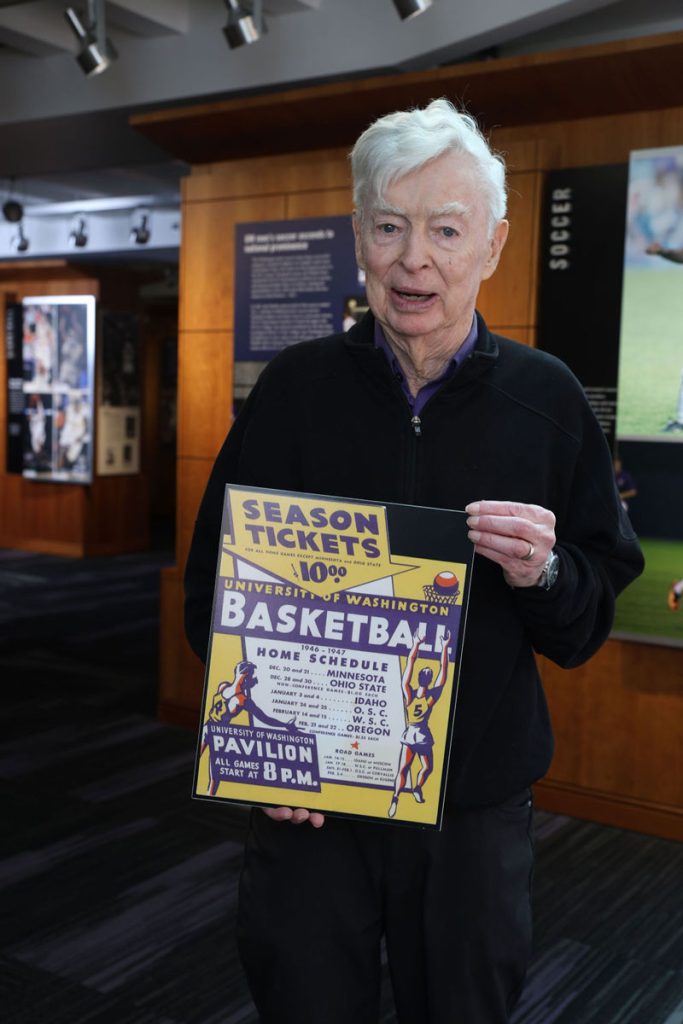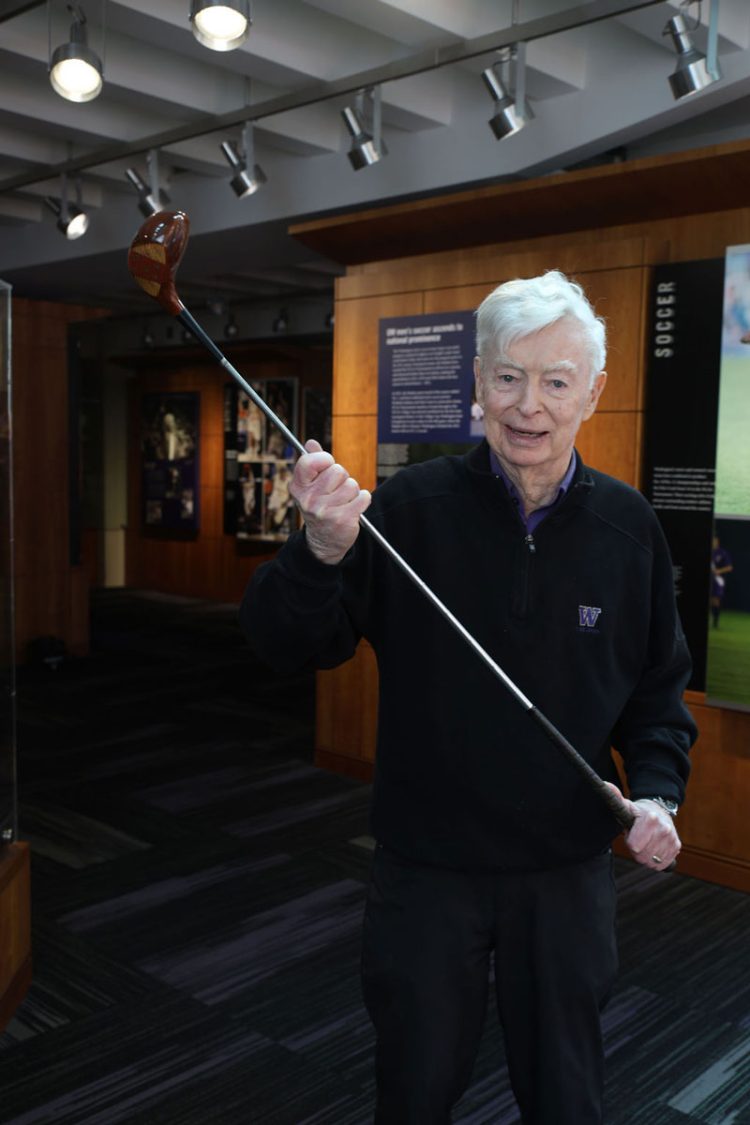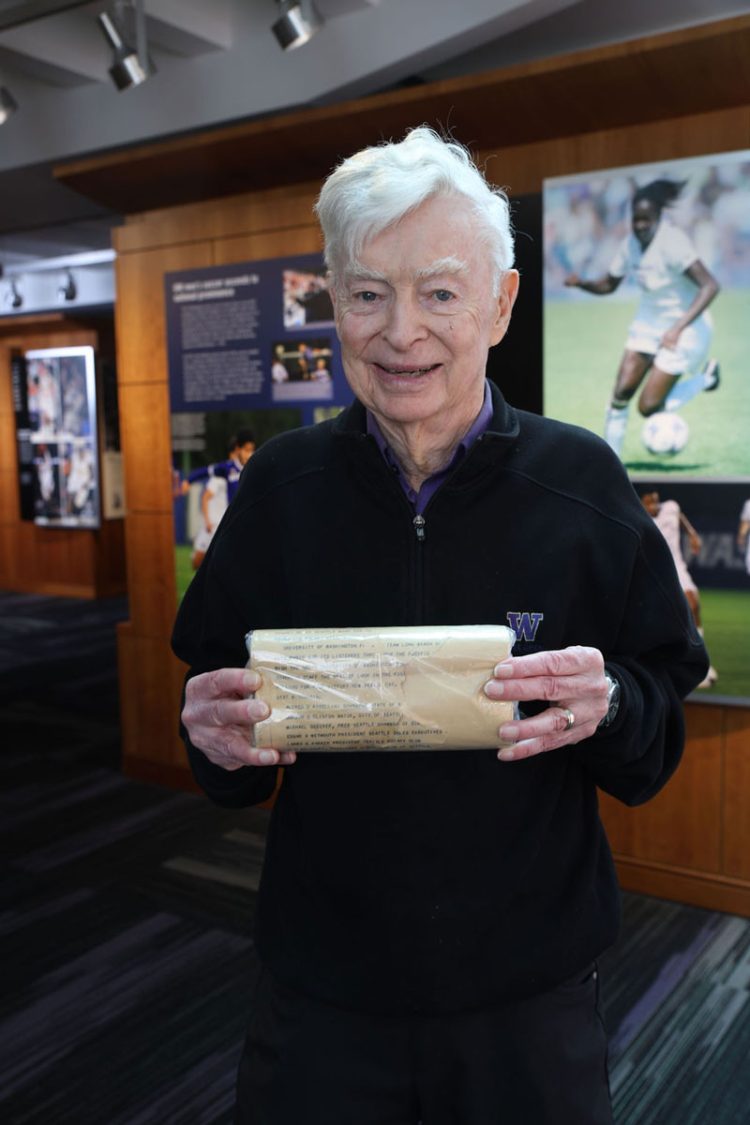
Husky fever Husky fever Husky fever
Dave Torrell's volunteer duties have included running a museum, acting as Don James and collecting one-of-a-kind memorabilia.
By Mike Seely | Photos by Ron Wurzer | September 2025
Clarence “Hec” Edmundson Pavilion is one of four active Division I fieldhouses in the United States that still boast their original exterior. The other three are Phog Allen Fieldhouse at the University of Kansas, Hinkle Fieldhouse at Butler University and Cameron Indoor Stadium at Duke University.

Can you believe season tickets to Husky basketball once cost $10? That was the case in1946-47, according to this poster on display at the Husky Fever Hall of Fame.
I know this because Dave Torrell, ’62, told me so upon meeting him late last year. He and his wife of 62 years, Karen, a Husky cheerleader in the early 1960s, are two of the most loyal Huskies you will ever meet. Torrell is a past recipient of both Don Palmer and Frank Orrico Awards from the UW Intercollegiate Athletics department. He was also a co-chairman of the Campaign for the Student-Athlete, which was primarily concerned with raising money for the 1999 renovation of Hec Ed, home to the Husky Hall of Fame.
Torrell is the Husky Hall of Fame’s volunteer curator and caretaker. These are roles that, at 85, he approaches with the vigor and attention to detail of a man a third of his age. A resident of Sammamish who crosses Lake Washington to check in on the Hall of Fame’s well-being about every other week, Torrell is calm, wily, quick of wit and sure of purpose—and charming to the point where one feels as though he invented the term.
“He’s just so enthusiastic about all the athletes, all the games,” says Marta Valdes, whose company, Doty + Associates, is responsible for producing the more polished elements of the Husky Hall, like the medallions with inductees’ visages on them. “I’m astounded by his memory. What’s contagious is Dave’s joy and his thrill at every little artifact he obtains. He’s the energizer bunny. He’s just mind-blowing.”
“I don’t think we had an idea of his competency for this going into it, and we sort of found a gem,” recalls Chip Lydum, UW’s associate athletic director for operations and capital projects. “He’s very precise. He has a high standard. He’s really good with people. He loves the University and has a great grasp of history and has a super great personality and witty sense of humor. He gets it and has the discipline to follow through.
“Dave always has these little quips, how he talks about life. He has all these stories. He says things like, ‘When Don James set an appointment, he wrote it in pen, not pencil.’”
Indeed, Torrell counted James and former UW men’s basketball coach Marv Harshman among his friends. He and James were golfing buddies out at Torrell’s home course of Sahalee, and the legendary Husky football coach once put Torrell on the spot by having him fill in for him at a Northwest coaching event in Portland, where Torrell lived for several years after graduation.
“Skip Hall (an assistant under James) calls me up and says, ‘Dave, are you going to the coach’s [event]?’ I said, ‘Uh, yeah,’ and he says, ‘Well, now you’re Don James because he’s not going.’”
Torrell says the event went “OK” despite the fact that the other coaches felt particularly slighted since James had just guided the Huskies to a win in the 1978 Rose Bowl against Michigan.

Carry a big club and win a title? That’s the wood driver that Charles Ainslie, ’64, the first scholarship golfer at the UW, used in the early 1960s to defeat USC’s Dave Stockton in a championship match. Stockton went on to win titles on the PGA Tour and Champions Tour.

Before the Huskies went to Pasadena to take on Wisconsin in the 1960 Rose Bowl, 10,000 fans signed a telegram to wish the team well.
Victory cigars & coach’s martini
About that win: Among the Husky Hall of Fame’s prized possessions is the ball Nesby Glasgow intercepted to put the game away. When Torrell initially approached Glasgow about housing the ball in the Husky Hall, the sensational ex-safety politely declined. But through perseverance, Torrell eventually won Glasgow over and got his ball.
This is not an uncommon occurrence.
“Dave is a master at getting to people’s homes and sitting with them and getting their jerseys and stuff,” says Lydum. “Dave is very committed to ensuring the quality of the hall of fame is updated every year and upgraded. He brings ideas to me before I have a chance to think of them. I don’t think that physical space would have had many upgrades in 25 years without Dave. It would have been 99th on everybody else’s to-do list. He has personally kept that space vibrant and up to date.”
The football from a game-clinching interception is the sort of item one might expect to find in any hall of fame, but it’s the smaller, more personal artifacts Torrell is able to source that puts the Husky Hall of Fame on a level all its own. There are shards of wood from the goal posts from victories in the 1960 and 1961 Rose Bowls; Player-Coach (in college!) Ralph Nichols’ Big W blanket from the 1890s, the oldest piece of memorabilia in the Husky Hall; and a Western Union telegram from John “The Duke” Wayne to his good pal Paul Schwegler, a standout UW tackle in the early 1930s who would go on to be inducted into the College Football Hall of Fame. (While this sampling is admittedly football-centric, rest assured that the Husky Hall features memorabilia from all sports, including basketball, baseball, softball, track and field, swimming, wrestling, and crew.)
And then there’s the Jim Owens Martini.
The Husky Hall came into possession of this high-octane cocktail recipe—44 parts vodka, eight parts dry vermouth—when a UW alum named Dr. Charles Stipp called up Torrell and asked if he wanted to hear about his experience with Owens after the Huskies defeated Wisconsin in the 1960 Rose Bowl. Former Husky lineman Carl Fennema, one of Owens’ best friends, met in person with Stipp and Torrell and presented Torrell with an ashtray that is now on display at the museum.
For most of the Husky Hall’s existence, Torrell has had to actively chase such memorabilia down. But as the Hall has gained more notoriety, Torrell says “it’s evolved to the point where people are coming in here with stuff.”
To wit, on one game day, the family of a Husky football player from Schwegler’s era named Bill Smith stopped by the Hall to see if Torrell would be interested in some of the left end’s keepsakes from his playing days. Included in this treasure trove were recruiting letters from the Green Bay Packers and Chicago Cardinals (this was before the NFL held a draft), extolling the virtues of their respective franchises and why theirs would be the best choice for Smith.
Smith would go on to play six seasons for the Cardinals, making first-team All-Pro in 1935, a campaign that saw him lead the league in field goals while pulling double duty as a placekicker. As for why he chose Chicago over Green Bay, it may or may not have had to do with the fact that the Packers addressed Smith’s letter to Pullman instead of Seattle.